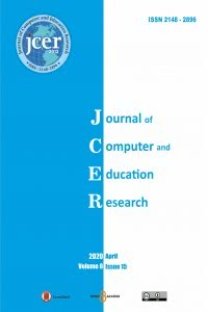Matematik Öğretmenlerinin Etkinlik Tasarım ve Uygulama Süreçlerinde Yaptıkları Değerlendirme ve Müdahalelerin İncelenmesi
Etkinlik, etkinlik değerlendirme, ön değerlendirme, süreç içinde değerlendirme, son değerlendirme
Analysis of the Evaluations and Interventions Made by Mathematics Teachers in the Activity Design and Implementation Process
Activity, activity evaluations, pre-implementation evaluation, evaluation in the implementation process, post-implementation evaluation,
___
- Ainley, J.,Pratt, D., & Hansen, A. (2006). Connecting engagement and focus in pedagogic task design. British Educational Research Journal, 32(1), 23-38.
- Aydın, A. (2014). Sınıf yönetimi. Ankara: Pegem Akademi.
- Boaler, J. (1993). Encouraging the transfer of ‘school’ mathematics to the ‘real world’ through the integration of process and content, context and culture. Educational Studies in Mathematics, 25(4), 341-373.
- Bozkurt, A. (2012). Matematik öğretmenlerinin matematiksel etkinlik kavramına dair algıları. Eğitim ve Bilim, 37(166), 101-116.
- Bozkurt, A. (2018). Ortaokul 6. sınıf matematik ders kitabındaki etkinliklerin amaç, öğrenci çalışma biçimi ve uygulanabilirlik yönleriyle değerlendirilmesi. Elektronik Sosyal Bilimler Dergisi, 17(66), 535-548.
- Bozkurt, A., & Güzel, M. (2019, Ekim). Etkinlik tasarım ve uygulamaya dair eğitimlerin ortaokul matematik öğretmenlerinin etkinlik ön değerlendirme becerilerine etkisi. Uluslararası Türk Bilgisayar ve Matematik Eğitimi Sempozyumu, Dokuz Eylül Üniversitesi, İzmir. Erişim adresi: http://www.bilmat.org/dosyalar/files/ozetler.pdf
- Bozkurt, A., & Kuran, K. (2016). Öğretmenlerin matematik ders kitaplarındaki etkinlikleri uygulama ve etkinlik tasarlama deneyim ve görüşlerinin incelenmesi. Ege Eğitim Dergisi, 17(2), 377-398.
- Choy, B. H. (2016). Snapshots of mathematics teacher noticing during task design. Mathematics Education Research Journal, 28(3), 421-440.
- Chua, B. L., & Toh, P. C. (2018). Tasks and activities in the mathematics classroom. Mathematics Instruction: Goals, Tasks and Activities-Yearbook 2018, Association of Mathematics Educators, 11.
- DeCuir-Gunby, J., Marshall, P., & McCulloch, A. (2011). Developing and using a codebook for the analysis of interview data: an example from a professional development research project. Field Methods, 23(2), 136-155.
- Fraenkel, J. R., Wallen, N. E., & Hyun, H. H. (2015). How to design and evaluate research in education (9. Ed.). New York: McGraw-Hill.
- Griffin, P. (2009). What makes a rich task?. Mathematics Teaching, 212, 32-34.
- Güzel, M. (2020). Matematiksel öğrenme etkinliklerinin tasarım ve uygulama niteliğinin değerlendirilmesi için bir model önerisi. Yayınlanmamış Doktora Tezi. Gaziantep Üniversitesi Eğitim Bilimleri Enstitüsü, Gaziantep.
- Harlen, W., & James, M. (1997). Assessment and learning: differences and relationships between formative and summative assessment. Assessment in Education: Principles, Policy & Practice, 4(3), 365-379.
- Henningsen, M., & Stein, M. K., (1997). Mathematical tasks and student cognition: Classroom-based factors that support and inhibit high-level mathematical thinking and reasoning. Journal for Research in Mathematics Education, 28, 524–549.
- Leung, A.,& Bolite-Frant, J. (2015). Designing mathematics tasks: The role of tools. In Task design in mathematics education (pp. 191-225). Springer, Cham.
- Liljedahl, P.,Chernoff, E., & Zazkis, R. (2007). Interweaving mathematics and pedagogy in task design: A tale of one task. Journal of Mathematics Teacher Education, 10(4-6), 239-249.
- Lozano, M. D. (2017). Investigating task design, classroom culture and mathematics learning: an enactivist approach. ZDM, 49(6), 895-907.
- Miles, M. B., & Huberman, A. M. (1994). Qualitative data analysis: an expanded sourcebook (2. Edition) CA: Sage. Thousand Oaks,
- National Council of Teachers of Mathematics (NCTM). (1991). Professional standards for teaching mathematics. Reston, Va.: The NCTM, Inc.
- Özmantar, M. F. & Bingölbali, E. (2009). Etkinlik tasarımı ve temel tasarım prensipleri. M. F. Özmantar ve E. Bingölbali (Ed.), Matematiksel Zorluklar ve Çözüm Önerileri (ss. 313-348).
- Özmantar, M. F., & Aslan, B. (2017). Matematiksel etkinliklerin uygulanması sırasında ortaya çıkan öğretmen ve öğrenci rolleri. International Journal of Social Science Research, 6(1), 1-23.
- Patton, M. Q. (2014). Nitel araştırma ve değerlendirme yöntemleri. (Çev. M. Bütün ve S.B. Demir). Ankara: Pegem Akademi.
- Robson, C. (2009). Real world research: a resource for social scientists and practitioner-researchers. Malden, MA: Blackwell.
- Stake, E., R., (1998). Case studies. N.K. Denzin & Y.S. Lincoln (Ed.) Strategies of qualitative inquiry. Thousand Oaks, CA: Sage.
- Stein, M. K., & Smith, M. S. (1998). Mathematical tasks as a framework for reflection: From research to practice. Mathematics Teaching in the Middle School, 3(4), 268-275.
- Stein, M. K., Grover, B. W., & Henningsen, M. (1996). Building student capacity for mathematical thinking and reasoning: An analysis of mathematical tasks used in reform classrooms. American Educational Research Journal, 33(2), 455-488.
- Stigler, J. W., & Hiebert, J. (1999). The teaching gap. New York: Free Press.
- Van de Walle, J. A., Karp, K. S., & Bay-Williams, J. M. (2009). Elementary and middle school mathematics: Teaching developmentally. New York, NY: Pearson Education.
- Watson, A. (2008). Task transformation is the teacher’s responsibility. Proceedings of the 32nd Annual Meeting of the North American Chapter of the International Group for the Psychology of Mathematics Education (Vol. 1, 147-153). Morelia, Michoacán, Mexico.
- Watson, A. (2016, July). Parameters for practice and research in task design in mathematics education. In 13th International Congress on Mathematical Education, Hamburg, Germany.
- Yayın Aralığı: 2
- Başlangıç: 2013
- Yayıncı: Tamer KUTLUCA
COVID-19 Salgını Sürecinde Uzaktan Eğitime İlişkin Tweetlerin Duygusal Analizi
Yükseköğretim Kurumlarında Eğitim Teknolojisi Üzerine Yapılmış Çalışmaların Analizi
How does Information and Communications Technology Influence Turkish Students’ Science Achievement?
Teachers’ Views on the Use of Mobile Phones in Schools
Sınıf Öğretmenlerinin Ekolojik Ayak İzi Farkındalık Düzeyleri
Mehmet DEMİRKOL, İbrahim ASLAN
“Sosyal Bilgiler Okuryazarlığı” Kavramına Yüklenen Anlamların Zihin Haritalarına Yansımaları
Zeynep BAŞCI NAMLI, Fatih KAYAALP, Elif MERAL
Öğretmenlik Uygulaması Dersine Yönelik Beklentilerin ve Sürecin Değerlendirilmesi
The Impacts of Behavioral Factors on Social Media Addiction
Gönül Zeynep SAVACI, Birgül Kutlu BAYRAKTAR, Çağla ÖZEN
